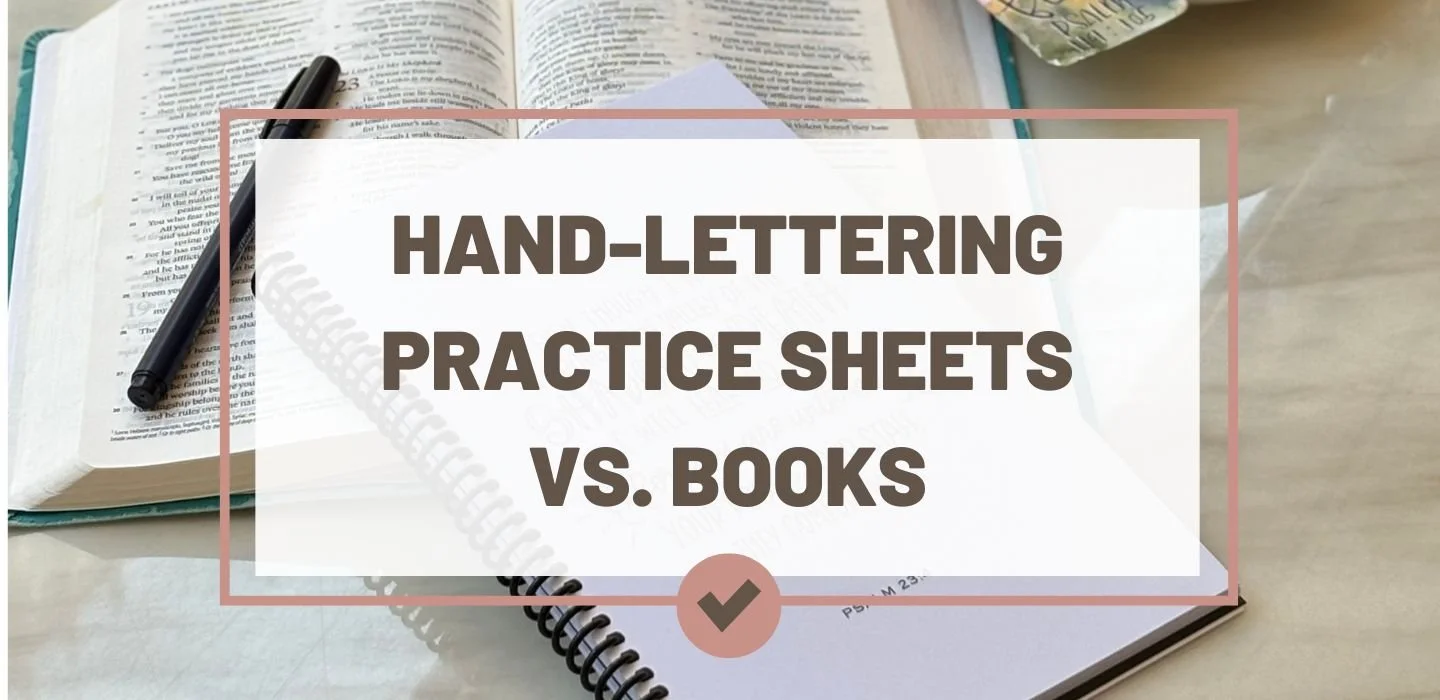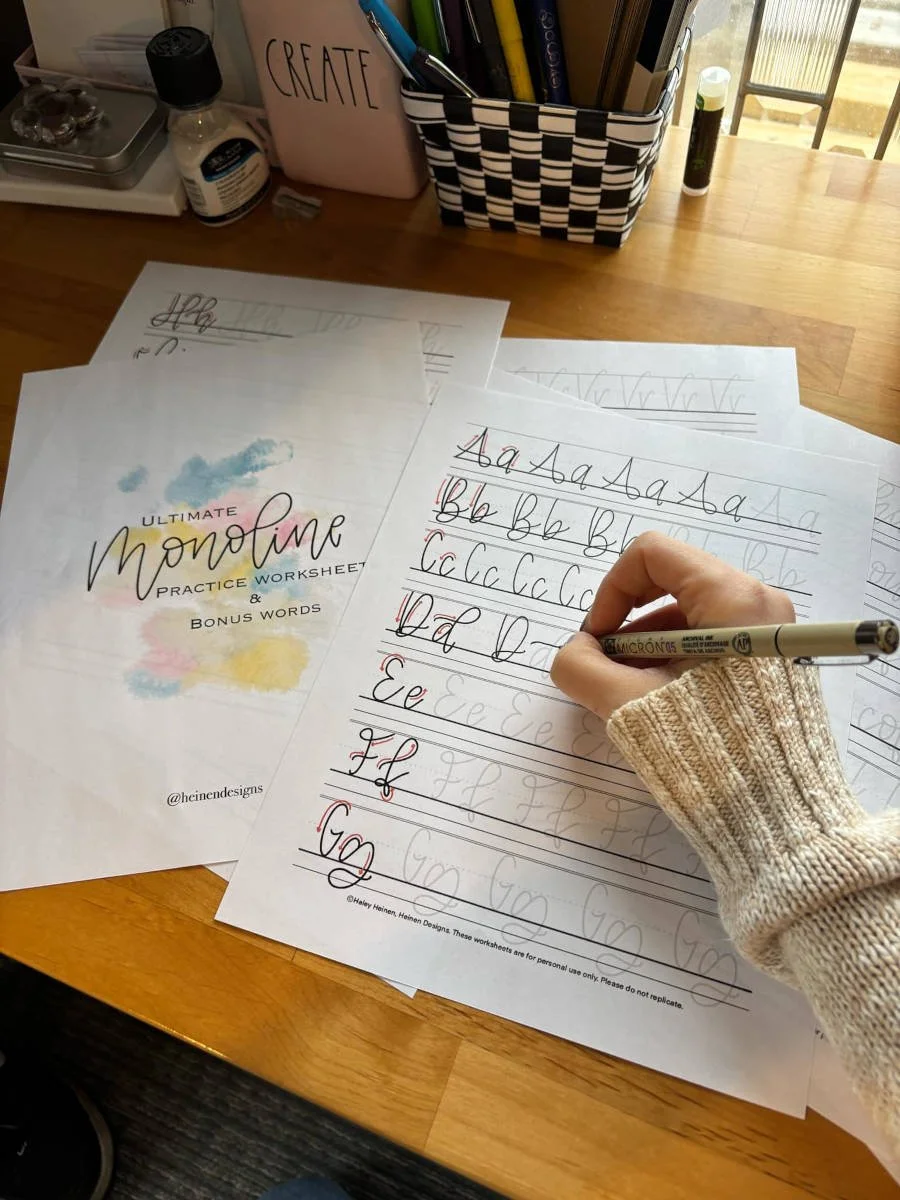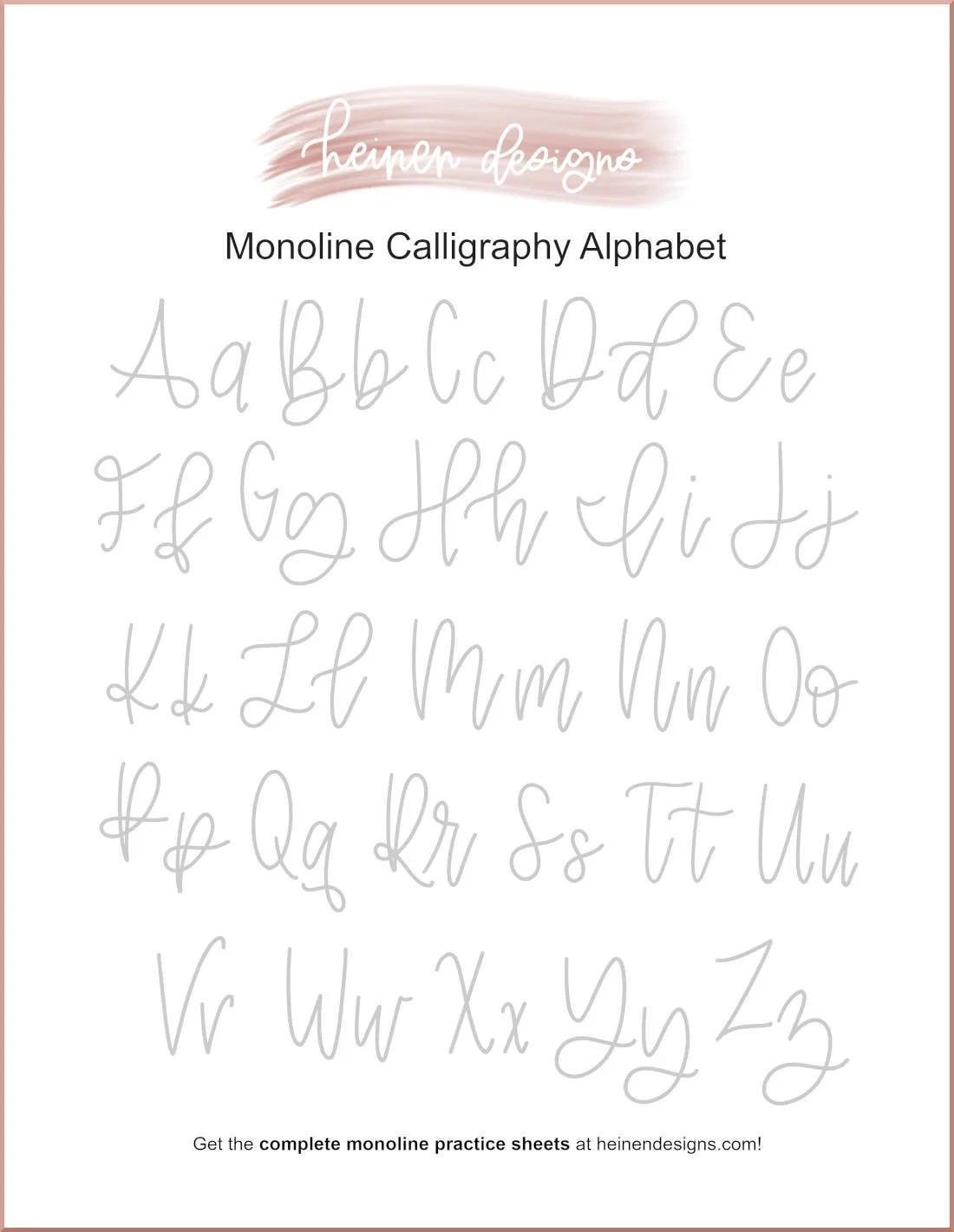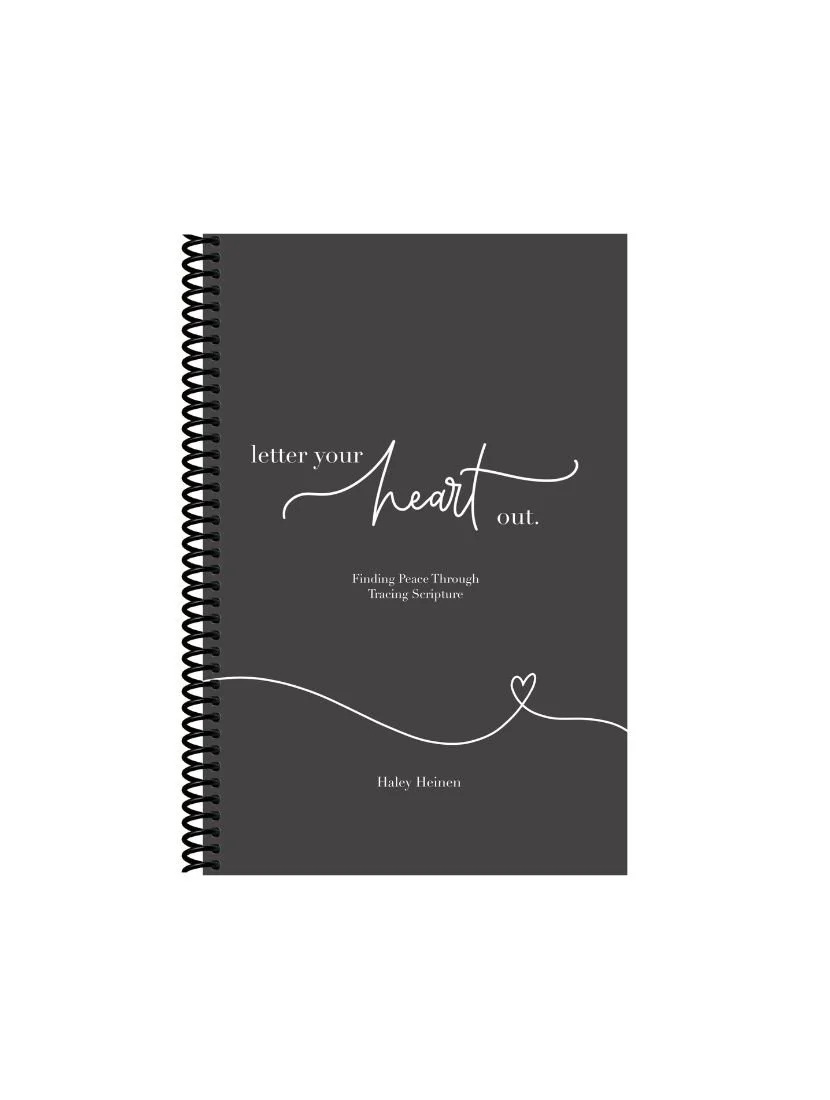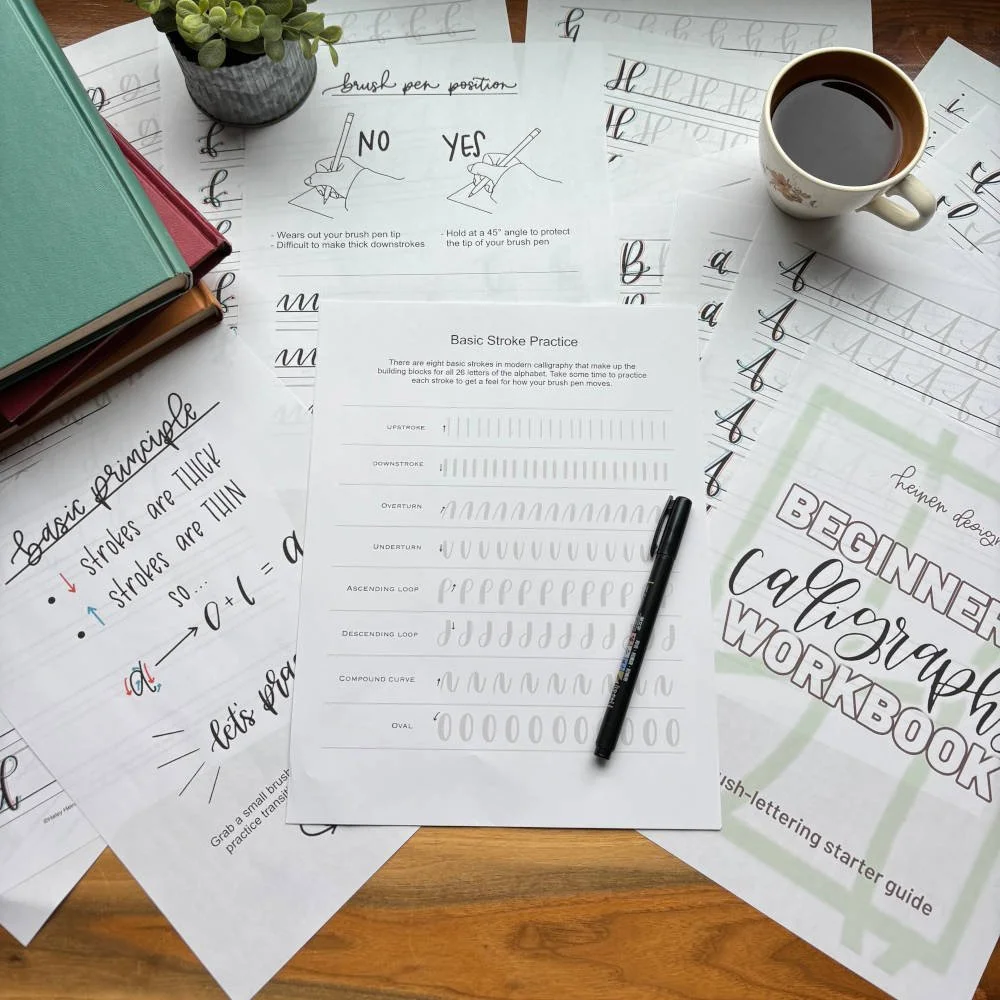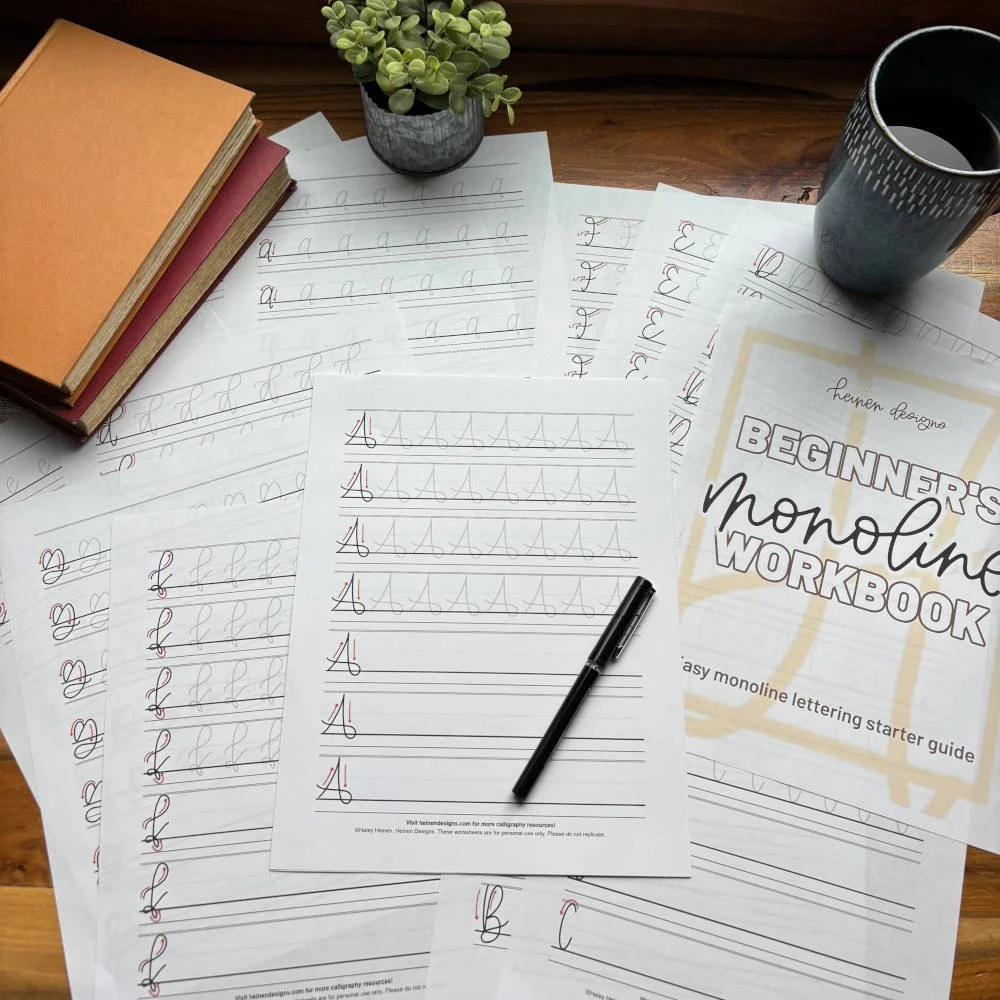Hand-Lettering Practice Sheets vs. Books: Which Is Right for You?
If you’re just getting started with hand-lettering, you’ve probably noticed the huge number of resources out there — from practice sheets to books, courses, and tutorials. One of the first questions many beginners ask is: Should I start with hand-lettering practice sheets or invest in a hand-lettering book?
The biggest distinction comes down to format: practice sheets are digital PDFs that you can print or use on an iPad, while books are printed resources that arrive ready to flip through and write in. Let’s break down the differences, benefits, and limitations of each so you can decide what’s best for your lettering journey.
Tap to jump to a topic:
Don’t forget to grab your free downloadable PDF practice sheet too!
What Are Hand-Lettering Practice Sheets?
Practice sheets are usually PDF files that you download instantly. They can be printed at home or loaded into an app like Procreate or GoodNotes for digital tracing. These sheets often include:
Basic strokes for brush calligraphy
Alphabet drills (uppercase and lowercase)
Words, phrases, or themed collections
Style-specific practice (e.g., monoline, brush-lettering, faux)
Because they’re printable, you can use them again and again, making them an affordable and flexible option.
What Are Hand-Lettering Books?
When it comes to printed lettering guides, as in books and workbooks, there are two main types:
Instructional books – These read more like a reference guide. They explain concepts like letterforms, spacing, composition, and creative design projects. Some include practice pages and exercises scattered throughout, but the focus is often on teaching and inspiring rather than endless tracing.
Workbooks – These are books built specifically for practice. They contain tracing alphabets, drills, and worksheets bound in a book format. You trace directly on the pages, so you can’t reuse them unless you buy another copy, but you don’t have to bother with printing.
Some publishers also release eBook versions of their lettering books or workbooks, but unlike PDF practice sheets, not all of them are formatted for easy tracing on a tablet.
The Benefits of Practice Sheets
One of the biggest advantages of practice sheets is their digital and reusable nature. Since they’re typically sold as PDF files, you can print them as many times as you’d like or use them digitally on a tablet. This means you’re never limited to a single copy. If you run out of space, simply print another page. Over time, this flexibility makes them incredibly cost-effective, since you don’t have to purchase new copies just to keep practicing the same drills.
Another benefit is instant access. The moment you purchase or download a practice sheet, it’s ready to use. There’s no waiting for shipping or worrying about whether a store has it in stock. For beginners who are eager to dive in, or for seasoned letterers who want to try out a new style right away, this “instant start” factor is a big deal.
Practice sheets also tend to be more affordable than printed workbooks. Because they’re digital, creators can offer them at a lower price point, making it easier for learners to build a library of different alphabets, styles, and drills without a big financial investment. You could buy several practice sheet sets for the cost of a single printed book, giving you more variety to explore.
Another key benefit is customization. Since practice sheets are often sold in sets by style or purpose, you can pick and choose exactly what you want to work on. Maybe you only need modern calligraphy lowercase letters, or you’re ready to jump into flourishes or brush pen drills. Unlike books, which may cover a wide range of topics, practice sheets let you zero in on your specific learning goals.
Finally, practice sheets are ideal for digital lettering practice. Many lettering artists now work on tablets with apps like Procreate, GoodNotes, or Adobe Fresco. Most practice sheet PDFs can be easily imported into these apps, letting you practice with an Apple Pencil or stylus just as you would with pen and paper. This makes them a perfect choice for artists who want to build skills in both printed brush lettering and digital calligraphy.
The Benefits of Hand-Lettering Books
Hand-lettering books offer something that practice sheets often can’t: a tangible, physical resource. For some learners, having a bound copy in front of them feels more motivating and less distracting than working off a digital screen. You don’t need to worry about printing, running out of ink, or importing files into apps — your learning tool is always ready to go. This makes calligraphy books especially convenient for beginners who just want to sit down and start practicing without dealing with extra steps.
Workbooks in particular are designed to be interactive, with built-in tracing sections and drills you can practice directly on the page. While you can only use these pages once (unless you trace over them on separate paper), they provide a straightforward, guided way to develop muscle memory. Many lettering artists enjoy the feeling of progressing through a workbook cover to cover, treating it almost like a course in book form.
The Advantages of Spiral-Bound Workbooks
If you’re leaning toward a workbook, one important detail to look for is how the book is bound. A spiral-bound or coil-bound workbook offers a huge advantage over traditional glued or sewn bindings: it lays completely flat on your desk. When you’re practicing hand-lettering, the last thing you want is to fight against a book that keeps closing on you or forces you to hold the spine open with one hand while you try to write with the other.
Spiral binding also makes it easier to focus on one page at a time. You can fold the workbook back on itself so only the page you’re working on is visible, which helps reduce distractions and keeps your workspace clean. This setup is especially helpful for drills or tracing sections, where consistency and comfort are key.
While traditional hardback or paperback lettering books are fantastic for instruction and inspiration, spiral- or coil-bound workbooks are designed with practical, hands-on use in mind. If your goal is to spend a lot of time tracing, drilling, and repeating strokes directly in the book, a spiral-bound workbook will almost always give you a smoother and more comfortable experience.
The Limitations of PDF Practice Sheets
While PDF practice sheets are incredibly convenient, they aren’t without drawbacks. One of the biggest limitations is the printing factor. To use them on paper, you’ll need access to a home printer or a reliable print shop or perhaps your local library. Depending on your printer quality, ink, and paper type, the results can vary, and over time the cost of ink and paper can add up.
Durability can also be a challenge. Because you’re printing the pages yourself, the quality depends on your paper choice. Regular printer paper tends to bleed with brush pens, fray nibs quickly, and just doesn’t feel as smooth as the heavier paper found in most workbooks. If you want a more authentic calligraphy experience, you’ll likely need to invest in higher-quality paper, which adds another expense.
Finally, while PDFs are endlessly reusable, they can be easy to forget about. It’s common for beginners to download a big bundle of practice sheets, print a few, and then let the rest sit on their computer untouched. Without the physical presence of a book sitting on your desk or shelf as a reminder, it takes a bit more discipline to consistently use digital practice sheets.
In short, PDFs are flexible, affordable, and customizable, but they do put more of the responsibility on you to handle printing, paper selection, and practice consistency.
The Limitations of Books
As helpful as hand-lettering books and workbooks can be, they also come with a few drawbacks that are worth considering before you invest.
The biggest limitation is that books aren’t infinitely reusable the way digital PDFs are. Once you’ve traced over or filled in the pages of a workbook, that practice space is gone. If you want to revisit an exercise, you’ll need to either buy a new book, carefully work on tracing paper over the original pages, or photocopy them if the binding allows. That means your long-term use is more limited compared to practice sheets that can be reprinted endlessly.
Books also come with format limitations. A traditional bound book doesn’t always lay flat, which makes it difficult to comfortably letter across both pages. While spiral-bound workbooks solve this problem (as we discussed earlier), many lettering books on the market are still bound in a way that isn’t very practical for tracing or practice. This can be frustrating if you’re trying to keep your strokes consistent but fighting against the spine of the book.
Another factor is cost and accessibility. Workbooks tend to be more expensive than downloadable PDFs, especially if you’re buying multiple titles to cover different styles. And if you’re outside of major markets, shipping costs or availability might make it harder to get your hands on the specific book you want. PDFs, by contrast, are instantly available no matter where you live.
Lastly, books can sometimes feel less customizable. You’re limited to the layouts, spacing, and instruction the author chose, whereas digital practice sheets allow you to pick and print exactly the exercises you want, as many times as you need. For a beginner, that rigid structure can be helpful, but for someone who likes to experiment and revisit drills often, it may feel restrictive.
In short, while books and workbooks provide structure, high-quality paper, and expert guidance, they don’t offer the same level of flexibility and repeatability as digital practice sheets.
Which One Is Right for You?
So, should you go with practice sheets or invest in a hand-lettering book? The answer really depends on your learning style, your goals, and your budget.
If you want flexibility, affordability, and endless reuse, PDF practice sheets are hard to beat. They’re perfect for beginners who want to build muscle memory through repetition and like the option to reprint pages whenever they need extra practice. They’re also ideal if you prefer working digitally on an iPad or tablet.
On the other hand, if you thrive with structured lessons, expert guidance, and a physical resource you can keep on your shelf, a hand-lettering book may be the better choice. Workbooks in particular can help you move through exercises in a logical order, while spiral-bound ones give you a more user-friendly format for tracing and practicing.
Ultimately, you don’t have to choose just one. Many lettering artists use both, starting with practice sheets for foundational drills, then moving into a workbook for more comprehensive learning of a particular style, and then even moving back into practice sheets to expand into another style or digital lettering. Whichever route you take, the key is consistency: regular practice is what will grow your skills, not getting the format just right.
And if you’re ready to dive in, start with a few free downloadable practice sheets — they’ll give you instant access to the basics and let you test the waters to find out what you like. Once you feel more confident, you can explore a purchasable PDF download or a full hand-lettering book to expand your horizons and keep your creative journey moving forward.


